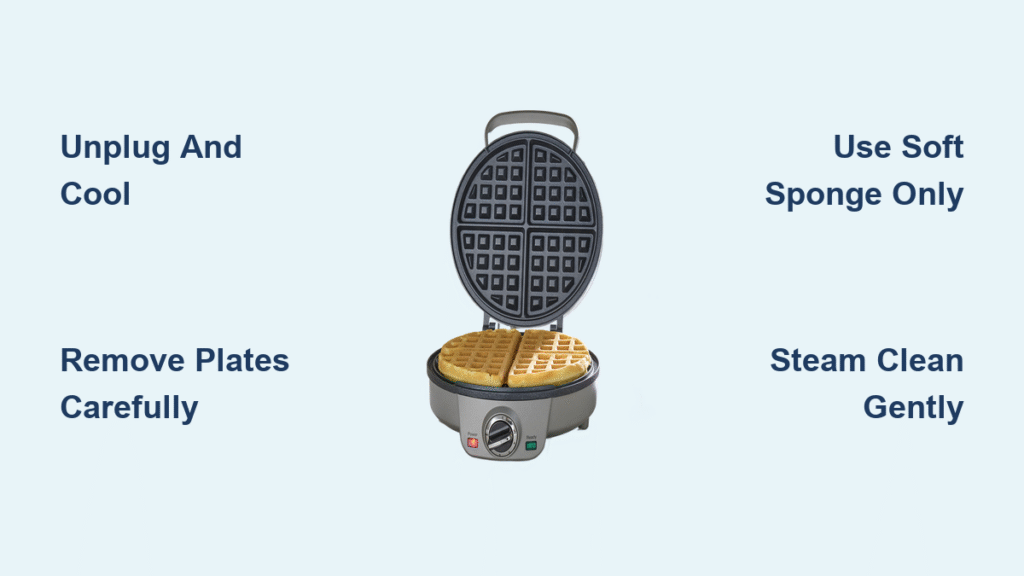Your Cuisinart enameled cast iron Dutch oven has seen better days. That creamy white interior now shows stubborn tomato sauce stains, and you’re wondering if those dark patches will ever come out. The good news is that proper cleaning techniques can restore your pot’s original luster while protecting its delicate enamel coating. Knowing how to clean Cuisinart enameled cast iron correctly means the difference between a cookware piece that lasts decades versus one that deteriorates prematurely. This guide reveals the exact methods that safely remove even the most stubborn stains while preserving your investment for generations of cooking.
Unlike traditional cast iron, enameled cast iron requires specialized care that balances effective cleaning with enamel protection. Many home cooks accidentally damage their prized Dutch ovens by using harsh scrubbers or improper techniques that compromise the glass-like enamel surface. By following these proven methods, you’ll maintain that smooth, non-porous cooking surface that makes Cuisinart enameled cast iron so valuable in your kitchen. Get ready to discover how to tackle burnt-on food, discoloration, and exterior marks without risking chips or cracks in your cookware.
Hand Wash After Every Use to Prevent Permanent Staining
The foundation of how to clean Cuisinart enameled cast iron properly starts with your daily routine. Never put these pots in the dishwasher—commercial detergents contain harsh chemicals that gradually dull the enamel finish over time. Instead, wash your Cuisinart immediately after cooking while it’s still warm (but not hot) using hot water, mild dish soap, and a soft sponge or non-abrasive pad. Focus your cleaning on food debris without aggressive scrubbing that could weaken the enamel surface.
Critical timing matters: Wait until your pot has cooled enough to touch comfortably before washing—never plunge hot cookware into cold water. This thermal shock risks cracking the enamel. As you wash, pay special attention to the rim where enamel meets exposed cast iron, as this area is particularly vulnerable to moisture damage.
Immediate Drying Protocol
The moment you finish washing, dry your Cuisinart enameled cast iron thoroughly with a clean towel. Unlike the enamel interior, the thin band of raw cast iron along the rim can develop rust if left damp. Make sure to:
- Dry the entire cooking surface completely
- Wipe the rim and lid edges carefully
- Pay special attention to crevices where moisture collects
- Never let your pot air-dry on a dish rack
Pro tip: Keep a dedicated towel near your stove specifically for drying enameled cast iron—this prevents cross-contamination with other kitchen tasks and ensures immediate drying.
Boiling Water Method for Burnt Food Removal
When food sticks stubbornly to your Cuisinart enameled cast iron, the boiling water technique provides a gentle yet effective solution that won’t scratch the enamel surface. This method works surprisingly well for cheese, grains, or sauces that have baked on during cooking.
Step-by-Step Burnt Food Removal
Follow this exact process for optimal results:
- Fill your pot halfway with tap water
- Bring to a rolling boil uncovered for 2-3 minutes
- Turn off the heat source completely
- Use a wooden spatula to gently scrape the bottom
- Carefully pour off the hot water
- Let the pot sit for 2-3 minutes to allow residue to flake off
- Wash normally with dish soap and a soft sponge
Time-saving insight: This entire process takes less than 10 minutes and prevents the need for aggressive scrubbing that could damage your cookware. The heat loosens food particles while the wooden tool protects the enamel surface.
Bleach Solutions for White Interior Stain Removal

Light-colored enamel interiors show every mark, but manufacturer-approved bleach solutions safely restore that pristine white finish without damaging the enamel coating. These techniques work particularly well for tomato-based sauces that cause orange discoloration.
Mild Bleach Treatment for Early Stains
For light discoloration caught early:
- Mix 1 teaspoon bleach per 1 pint of water
- Soak for 30 minutes
- Wash thoroughly with dish soap
- Dry completely
This gentle solution effectively lifts stains before they become permanent, making it perfect for weekly maintenance on frequently used pots.
Overnight Bleach Soak for Severe Discoloration
For stubborn stains that interfere with monitoring food browning:
- Create a solution of 1 part bleach to 3 parts water
- Fill the stained pot completely with this mixture
- Cover and soak overnight (8-12 hours)
- Pour out solution and wash normally
- Repeat once more for extremely dark stains
Critical safety note: Never mix bleach with other cleaners or use this solution on colored enamel exteriors. Always work in a well-ventilated area and wear gloves.
Baking Soda Deep Cleaning Techniques
Baking soda provides a natural alternative to bleach that effectively removes stains from both interior and exterior surfaces of your Cuisinart enameled cast iron.
Boiling Baking Soda Method
This bubbling technique works wonders on interior stains:
- Fill your Dutch oven with water and bring to a boil
- Slowly add 3-4 tablespoons of baking soda (expect foaming)
- Simmer for 10 minutes while gently scraping with a wooden spoon
- Drain and wash with dish soap using a non-abrasive sponge
- Continue gentle scrubbing until stains disappear
Visual cue: Watch for the water to turn dark as it lifts stains from the enamel surface—this shows the process working effectively.
Overnight Baking Soda Paste for Stubborn Marks
For persistent discoloration that won’t respond to boiling:
- Mix baking soda with a few drops of water to form a toothpaste-like consistency
- Apply a thick layer to stained areas
- Cover the pot and let sit overnight
- Scrape off the paste with a wooden spoon the next morning
- Wash thoroughly with soap and a soft sponge
Pro insight: This paste method works equally well on colorful exterior enamel without dulling the finish, making it perfect for restoring both interior and exterior surfaces.
Prevent Chipping and Cracks During Cleaning

The glass-like enamel coating on your Cuisinart cast iron requires special handling to avoid damage during cleaning and storage.
Safe Utensil Selection for Cleaning
Always use:
– Wooden spoons and spatulas
– Silicone-coated cleaning tools
– Nylon scrubbers specifically designed for non-stick surfaces
Never use:
– Metal scouring pads
– Steel wool
– Abrasive cleaners
– Sharp utensils for scraping
Storage tip: When stacking enameled cast iron pieces, place a soft cloth or folded paper towel between them to prevent contact chips.
Temperature Management During Cleaning
Enamel cracks from sudden temperature changes. Follow these critical rules:
- Never add cold water to a hot pot
- Avoid washing immediately after cooking—allow to cool first
- Never place a hot pot on a cold surface
- Don’t use high heat settings for dry cooking
Warning: Even small thermal shocks accumulate damage over time, eventually causing hairline cracks in the enamel surface.
Season Exposed Iron Edges Properly
Unlike traditional cast iron, your Cuisinart enameled cast iron requires seasoning only on the thin band of exposed cast iron along the rim.
Correct Seasoning Process
- Apply a thin coat of canola oil to the exposed rim only
- Place pot upside down on a foil-lined baking sheet
- Bake at 350°F for 1 hour
- Turn off oven and allow to cool completely inside
Frequency guideline: Season the rim 2-3 times yearly, or whenever you notice dull gray spots indicating oxidation. This simple process prevents rust formation on the vulnerable raw iron edges.
Avoid These Common Cleaning Mistakes
Many home cooks unknowingly damage their Cuisinart enameled cast iron through these preventable errors:
- Dishwasher use: The high heat and harsh detergents dull enamel over time
- Aggressive scrubbing: Steel wool creates micro-scratches that trap stains
- Overnight water soaking: Causes rust on exposed iron edges
- Cooking spray residue: Creates a sticky buildup that becomes permanent
- Empty pot heating: Causes thermal shock and potential cracking
Critical mistake to avoid: Never use oven cleaner on enameled cast iron—it contains chemicals that permanently damage the enamel surface.
Long-Term Care Strategy for Generational Use
Your Cuisinart enameled cast iron can become a family heirloom with proper maintenance. Even small enamel chips don’t ruin the pot—the underlying cast iron remains safe for cooking. Focus your efforts on:
- Prompt cleaning after each use before stains set
- Gentle stain removal at first signs of discoloration
- Rim maintenance to prevent rust development
- Proper storage with lids slightly ajar to prevent moisture buildup
Pro insight: The first year of use creates a natural patina on the enamel that actually improves cooking performance. After this initial period, food releases more easily and stains become less noticeable.
| Stain Type | First Try | Heavy Duty | Avoid |
|---|---|---|---|
| Light discoloration | Baking soda boil | Bleach solution (mild) | Abrasive cleaners |
| Burnt food | Boiling water method | Overnight baking soda paste | Metal scouring |
| Exterior marks | Baking soda paste | Soft scrub sponge | Oven cleaner |
| Rim rust | Season with oil | Wire brush + re-season | Leaving wet |
Bottom line: How to clean Cuisinart enameled cast iron properly comes down to gentle, consistent care. Skip the harsh chemicals and aggressive scrubbing—these damage the enamel over time. Instead, clean promptly after cooking, treat stains early before they set, and maintain the exposed iron edges with proper seasoning. Your Dutch oven will reward you with decades of flawless performance, becoming more nonstick and cherished with each passing year. By following these specific techniques, you’ll preserve both the beauty and functionality of your Cuisinart enameled cast iron for generations to come.





